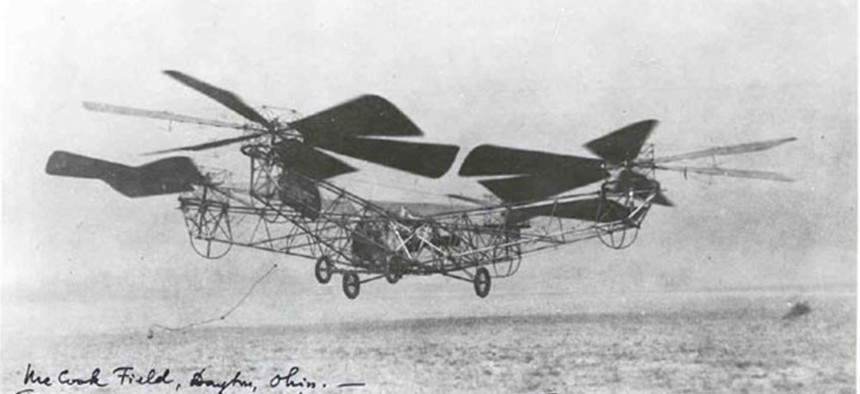
A helicopter designed by George DeBothezat, makes a descent at McCook Filed after remaining airborne for nearly 3 minutes. National Park Service
This Is the Ancestor of Today's Military Helicopters
A Russian engineer - with funding from the US military - designed and built the quadcopter that evolved into today's aerial weapons. By Sarah Laslow
In 1927 George de Bothezat told Popular Science that helicopters were "exactly where the airplane stood after the first few flights of the Wright Brothers."
What he means is that helicopters had, indeed, flown. Bothezat himself had built one that lifted off the ground while carrying the weight of four people. They just hadn't flown well.
De Bothezat's helicopter wasn't the first to get off the ground, but it was the first that the U.S. military took seriously. A Russian engineer who had fled the revolution, de Bothezat had come to the United States and built a prototype helicopter. The U.S. Air Service was intrigued and in 1921 gave him a contract for $200,000 —about $2.8 million in today's dollars.
As part of that contract, he had to "design, construct and supervise flight tests of a helicopter," and would receive additional bonuses on top of his $10,000 annual salary, if he hit certain marks—turn in a set of plans, construct the actual machine, and fly it 300 feet into the air and land safely. He had seven months.
The machine he built was a quadcopter, 10 feet high and in the shape of a cross, each one 65 feet long, with a six-bladed rotor on either end. The engine went in the middle, with the pilot. It took much longer than seven months—it did not fly until December of 1922.
As ungainly as it was, the helicopter flew better than any other to that point. It could carry passengers and could hover in the air for almost three minutes. But within a few years, the Air Service lost interest in funding the project.
Almost two decades later, Igor Sikorsky, another Russian engineer who come to America in the wake of the Bolshevik takeover, designed the first helicopter the military would actually use. In its basic elements, it looked much like the helicopters that predominate today:
Today, quadcopters like the one de Bothezat designed are having a newfound moment of technological ascendence—instead of lifting people into the air, they've become the standard in personal unmanned aerial vehicles. Most people who control vertical flying machines right now, are controlling little versions of the one de Bothezat made almost a century ago.




